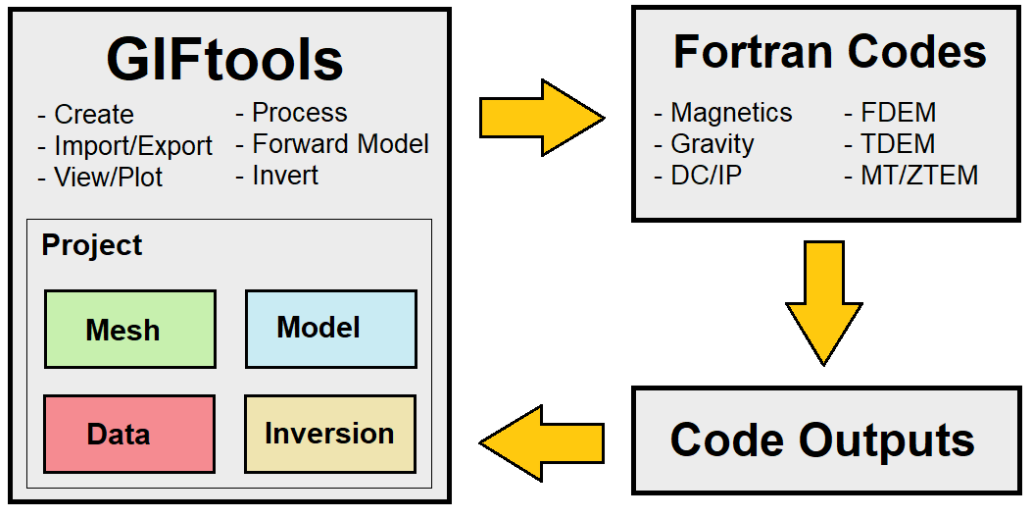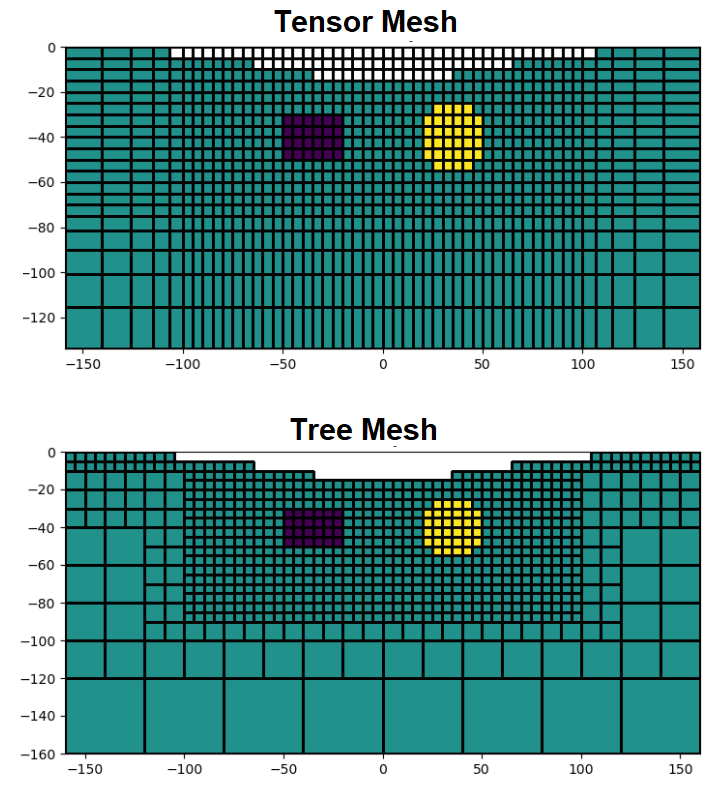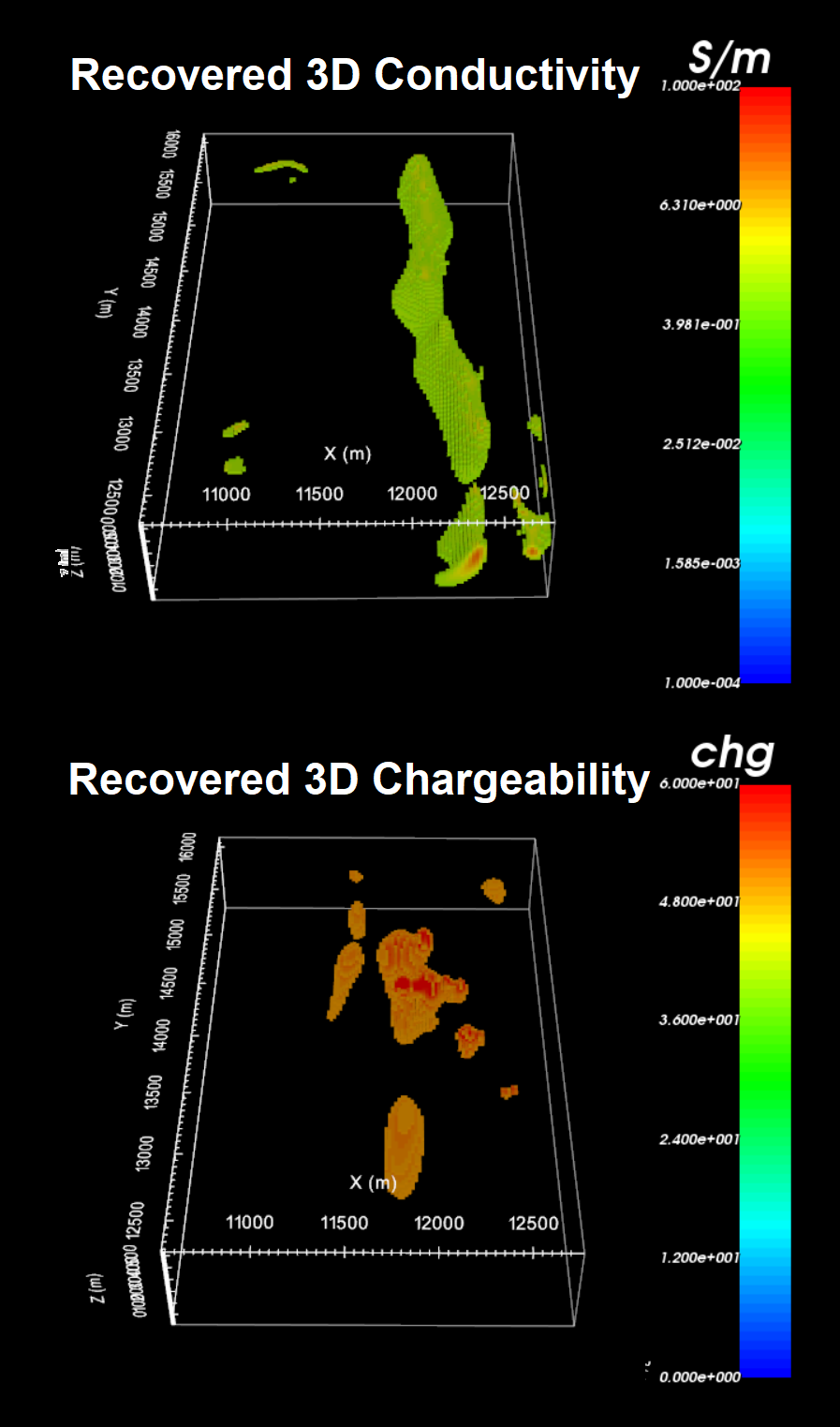Past Research Consortia
GIFtools I and II Consortia (2012 - 2018)
The GIFtools I and II consortia were funded by NSERC and 7 private mining companies. The primary goal of the GIFtools consortia was to create a graphical user interface for loading, viewing, and processing geophysical data, as well as interface with UBC-GIF Fortran forward modeling and inversion codes. Commonly encountered challenges in interpreting, processing and inverting geophysical data were identified. And this information was used to improve and create new methodologies for geophysical data processing and inversion.

Research Highlights:
- Gravity and magnetic inversion algorithms were greatly improved over this time. Highlights include:
- An iteratively re-weighted least-squares inversion algorithm to recover compact and blocky structures using sparse-norms.
- Magnetics codes capable of forward modeling and inverting amplitude and TMI data
- A magnetic vector inversion (MVI) code which can be used to recover a magnetization model in the presence of strong remanent magnetization
- Finite volume OcTree PDE codes for magnetic and gravity. For magnetics, this is necessary when the demagnetization field is sufficiently strong.
- A novel 3D forward modeling and inversion approach for airborne induced IP
- A parametric inversion algorithm for EM data
- A novel 3D forward modeling and inversion algorithm, which can be used to remove viscous remanent magnetization (VRM) signals from inductive source TEM data
- A mesh decoupling (tile-mesh) forward modeling and inversion algorithm to reduce the computational demands of airborne EM data
Sponsors: Anglo-American, Barrick Gold, BHP, Glencore, Rio Tinto, Teck and Vale
IRC II Consortium (2017 - 2018)
The IRC II consortium was funded by NSERC and 6 private mining companies. This consortium continued the work completed in the previous IRC consortium. Second generation OcTree codes were developed which allowed the user to define source and receivers of any dimension/orientation; whereas before, only the Cartesian components of the field were modeled. To further reduce the time required to invert airborne EM data, "tiled" codes were written. In these codes, the forward problem is solved independently for each transmitter on a small decoupled mesh.
Research Highlights:
Codes developed under the IRC II consortium include:
- E3D v2: A second generation code for forward modeling and inverting FEM data on an OcTree mesh, where sources and receivers can be defined for arbitrary dimensions/orientations
- E3D v2 tiled: A second generation code for forward modeling and inverting FEM data on an OcTree mesh, where 1) sources and receivers can be defined for arbitrary dimensions/orientations and 2) the forward problem is solved independently for each transmitter on a small decoupled mesh
- E3DMT v2: A second generation code for forward modeling and inverting MT and ZTEM data on an OcTree mesh, where sources and receivers can be defined for arbitrary dimensions/orientations
- TDoctree tiled: Forward modeling and inversion of TEM data on an OcTree mesh, where the forward problem is solved independently for each transmitter on a small decoupled mesh
- TDoctree v2: A second generation code for forward modeling and inverting TEM data on an OcTree mesh, where sources and receivers can be defined for arbitrary dimensions/orientations
Sponsors: Anglo-American, BHP, Glencore, Rio Tinto, Teck and Vale
IRC I Consortium (2012 - 2016)
The IRC I consortium was funded by NSERC and 7 private mining companies. The goal of this consortium was to create new EM forward modeling and inversion codes which solve for the fields on an OcTree mesh; as opposed to a tensor mesh. Compared to tensor meshes, OcTree meshes allows for finer discretization in the region of interest and a decrease in the number of redundant cells in the padding while keeping overall number of cells in the mesh manageable. The latest advancements in parallelization with MPI and direct solvers (MUMPS) were implemented, resulting in a suite of EM codes viable for commercial use.
 Research Highlights:
Research Highlights:
Codes developed under the IRC I consortium include:
- OcTree Utilities: A set of utility codes for interpolation, constructing models and creating weights for OcTree meshes
- DCIP OcTree: Forward modeling and inversion of DC and IP data on an OcTree mesh
- E3D: Forward modeling and inversion of FEM data on an OcTree mesh
- MTZ3D: Forward modeling and inversion of MT and ZTEM data on a tensor mesh
- E3DMT: Forward modeling and inversion of MT and ZTEM data on an OcTree mesh
- TDoctree: Forward modeling and inversion of TEM data on an OcTree mesh
Sponsors: Anglo-American, Barrick Gold, BHP, Glencore, Rio Tinto, Teck and Vale
MITEM Consortium (2006 - 2009)
The Multi-source Inversion of Time-domain ElectroMagnetic (MITEM) data was funded by NSERC and 6 private mining companies. The research goal was to write improved algorithms for forward modeling and inverting time-domain electromagnetic data. A major obstacle in modeling real-world survey geometries is that a large linear system must be solved for every source (i.e. unique transmitter and waveform). Airborne survey have hundreds or even thousand of sources, making inversion of 3D airborne EM data extremely impractical. Our solution was obtained by factorizing the forward modelling matrix so that fields from each new source location can be quickly generated. As a result, surveys involving hundreds of transmitters and earth models composed of a half million cells became tractable on a relatively modest cluster of workstations.

Research Highlights:
Features of the improved 3D TEM forward modeling and inversion algorithms are as follows:
- Model the E-field, H-field and dB/dt in the air, on the Earth's surface or in boreholes.
- Model the fields for arbitrary EM source types; i.e. galvanic or inductive for arbitrary orientations/dimensions.
- Invert any combination of E-field, H-field and/or dB/dt data
- Factor the forward problem so that solutions for large numbers of sources can be done efficiently.
Additional research accomplishments during this time include:
- Model of 1D time-domain EM data in the case of dispersive electrical conductivity (IP) and magnetic susceptibility (viscous remanent magnetization)
- Update pre-existing EM codes with modern solvers.
Sponsors: XStrata Nickel, CVRD Inco Limited, Newmont Mining Corporation, Barrick Gold, Teck Cominco Ltd., Cameco Corporation - Exploration Division.
TIME Consortium (2003 - 2005)
The Time-domain Inversion and Modelling of Electromagnetic data consortium was funded by NSERC and 9 private mining companies. The primary focus was on forward modelling and inversion of 3D (three-dimensional) geophysical time-domain electromagnetic data. More specifically, upgrading pre-existing TEM codes to model inductive and galvanic sources, and adding the ability to model the E-field, H-field and dB/dt response.

Research Highlights:
- Wrote 3D forward modeling and inversion algorithms for time-domain electromagnetic data
- Capable of modeling E-field, H-field and dB/dt for galvanic and inductive loop sources
- Wrote GUIs for sponsors to interact with codes
Sponsors: Newmont, Falconbridge, Placer Dome, Anglo American, INCO, Electromagnetic Instruments Inc. (EMI), MIM, Cominco, AGIP, Muskox Minerals, BHP-Billeton and Rio Tinto
IMAGE Consortium (1999-2003)
The Inversion and Modelling of Applied Geophysical Electromagnetic (IMAGE) data consortium was funded by NSERC and 11 private mining companies. The primary focus was on writing algorithms to forward model and invert 3D electromagnetic data; which for this project included FEM, TEM, MT and ZTEM. This project involved a research collaboration with the Scientific Computing and Visualization group (SCV) in the Department of Computer Science at UBC. They also have a web page summarizing SCV's IMAGE work.

Research Highlights:
Sponsors received fully functional forward modelling and inversion codes, each with graphical user interfaces and utilities for viewing results. Codes produced during this consortium were:
- EM1DFM (1D forward modelling of frequency domain EM data),
- EH3D (3D forward modelling of frequency domain EM data);
- EH3Dinv (3D inversion of frequency domain EM data);
- MT3D (3D forward modelling of magnetotelluric data)
- MT3Dinv (3D inversion of magnetotelluric data).
- EH3DTD (3D forward modelling of time domain EM data)
Click here for an eight page summary of the research accomplishments from this project in Adobe PDF format.
Sponsors: Newmont, Falconbridge, Placer Dome, Anglo American, INCO, Electromagnetic Instruments Inc. (EMI), MIM, Cominco, AGIP, Muskox Minerals, BHP-Billeton and Rio Tinto
INDI Consortium (1997-1998)
The 3D INversion of DC Resistivity and IP (INDI) data consortium was funded by NSERC and 7 private mining companies. The goal was to develop strategies for 3D inversion of DC resistivity and IP data. A major objective was to invert surface and bore-hole data both separately and jointly. This objective was achieved.

Research Highlights:
- Wrote 3D inversion algorithms for both DC and IP. These algorithms can:
- Incorporate surface topography,
- Handle different electrode geometries (including borehole),
- Jointly invert surface and borehole data,
- Handle large problems (a few thousand data and a hundred thousand model parameters).
- Explored solutions to solving large inverse problems by incorporating:
- Wavelet transforms,
- Interior point methods,
- Generalized cross validation (GCV).
- Please see the Publications List.
- Case histories (eg the Mt Isa example).
Sponsors: Placer Dome, BHP Minerals, Cominco Exploration, Falconbridge, INCO Exploration & Technical Services, Newmont Gold Company and Rio Tinto
JACI Consortium (1991 - 1997)
The Joint And Cooperative Inversion (JACI) of geophysical and geological data consortium was funded by NSERC and 11 private mining companies. The goal was to develop strategies to invert individual geophysical data sets (2D DC/IP, 3D magnetics, 3D gravity, 1D EM) and to develop ways to incorporate other geophysical and geological data into the inversion. To help guide the research, we focused upon particular mineral sites and inverted all available geophysical data. The two primary sites were the Cu-Au porphyry deposit at Mt. Milligan (in British Columbia), and the Cu-Pb-Zn massive sulfide deposit at Heath Steele Stratmat (in New Brunswick).
Research Highlights:

- Created inversion methodologies for the following survey types:
- DC resistivity and IP (2D)
- Magnetics (3D)
- Gravity (3D)
- Electromagnetics (1D)
- Developed a fundamental approach for general geophysical inverse problems:
- Generalized subspace inversion for linear and nonlinear problems.
- Krylov subspace method for linear problems.
- Wavelet compression for large problems.
- Generalized cross validation.
- General measures of misfit.
- Developed joint and cooperative inversion methodologies
Sponsors: BHP Minerals, CRA Exploration, Cominco Exploration, Falconbridge, Hudson Bay Exploration and Development, INCO Exploration & Technical Services, Kennecott Exploration Company, Newmont Gold Company, Noranda Exploration, Placer Dome and WMC.


.png)